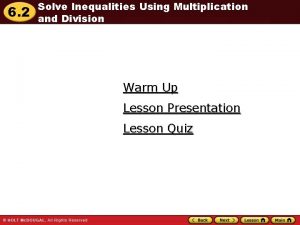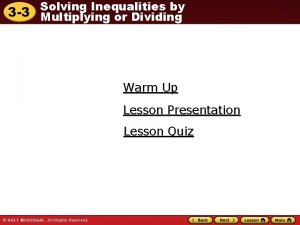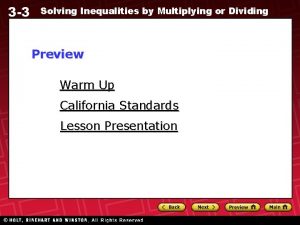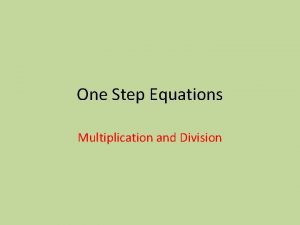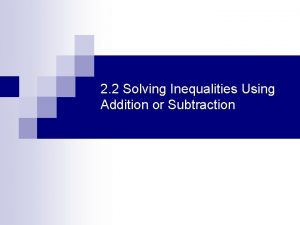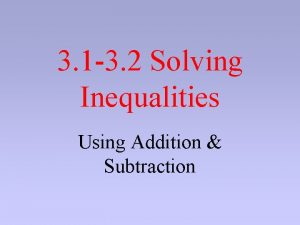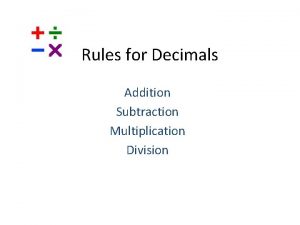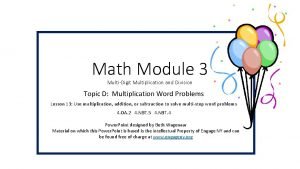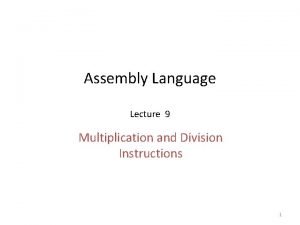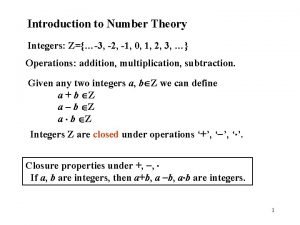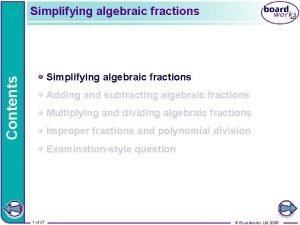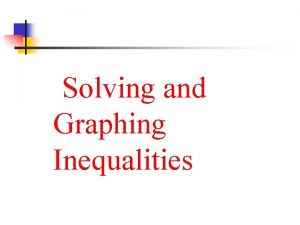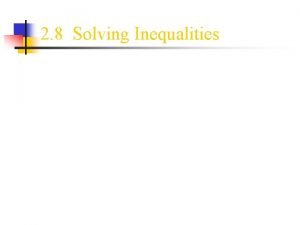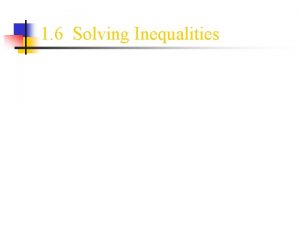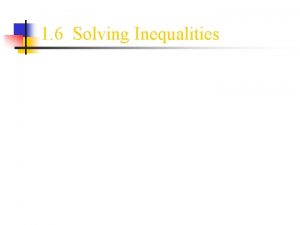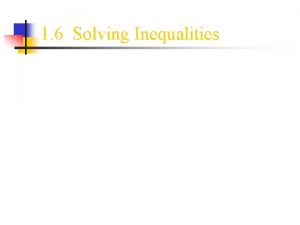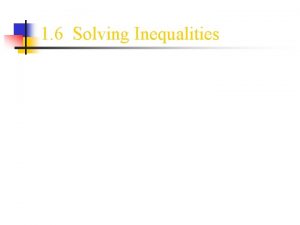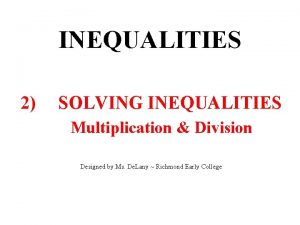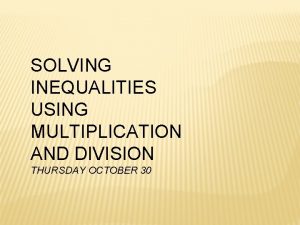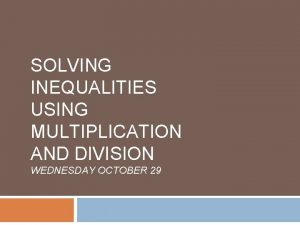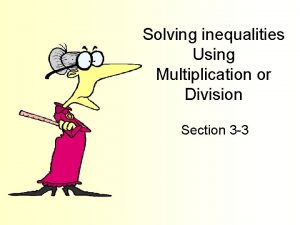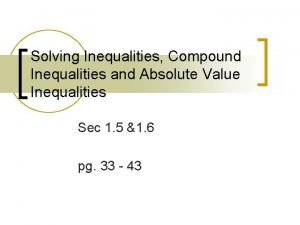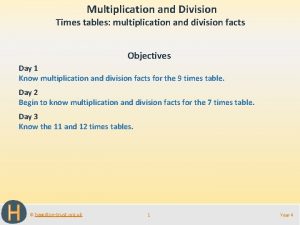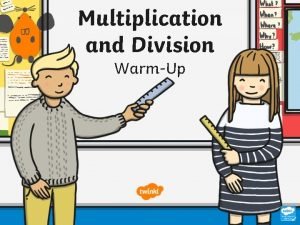6 2 Solving Inequalities Using Multiplication and Division


















- Slides: 18

6. 2 Solving Inequalities Using Multiplication and Division

EXAMPLE 1 Solve an inequality using multiplication x < 5. Graph your solution. 4 x < 5. 4 4 x <4 5 4 x < 20 Write original inequality. Multiply each side by 4. Simplify. ANSWER The solutions are all real numbers less than 20. Check by substituting a number less than 20 in the original inequality.

GUIDED PRACTICE for Example 1 Solve the inequality. Graph your solution. x 1. >8 3 SOLUTION x > 8. Write original inequality. 3 x 3 Multiply each side by 8. >8 3 3 x > 24 ANSWER Simplify. The solutions are all real numbers are greater than 24. Check by substituting a number greater than 24 in the original inequality.

GUIDED PRACTICE 2. for Example 1 m ≤– 2 8 SOLUTION 8 m ≤– 2 3 8 m < – 16 ANSWER Write original inequality. Multiply each side by 8. Simplify. The solutions are all real numbers less than are equal to – 16. Check by substituting a number less than – 16 in the original inequality.

for Example 1 GUIDED PRACTICE y 3. 2. 5 ≥– 4 SOLUTION y ≥– 4 2. 5 y ≥– 4 8 2. 5 y ≥ – 10 ANSWER Write original inequality. 2. 5 Multiply each side by 2. 5. Simplify. The solutions are all real numbers less than are equal to – 10. Check by substituting a number greater than – 10 in the original inequality.

EXAMPLE 2 Solve an inequality using multiplication x < 7. Graph your solution. Solve – 6 x Write original inequality. < 7. – 6 Multiply each side by – 6. Reverse – 6 x > – 6 7 inequality symbol. – 6 x > – 42 Simplify. ANSWER The solutions are all real numbers greater than – 42. Check by substituting a number greater than – 42 in the original inequality.

EXAMPLE 2 Solve an inequality using multiplication CHECK x – 6 <7 0 – 6 ? <7 0<7 Write original inequality. Substitute 0 for x. Solution checks

EXAMPLE 3 Solve an inequality using division Solve – 3 x > 24. – 3 x < 24 – 3 x<– 8 Write original inequality. Divide each side by – 3. Reverse inequality symbol. Simplify.

GUIDED PRACTICE 4. for Examples 2 and 3 x > 12 – 4 SOLUTION – 4 x – 4 > 12 x – 4 < – 4 12 x <– 48 Write original inequality. Multiply each side by – 4. Simplify. ANSWER The solutions are all real numbers greater than are equal to – 48. Check by substituting a number greater than – 48 in the original inequality.

GUIDED PRACTICE 5. for Examples 2 and 3 m < 1. 6 – 7 SOLUTION m – 7 < 1. 6 m – 7 < – 7 1. 6 m < – 11. 2 Write original inequality. Multiply each side by – 7. Simplify. ANSWER The solutions are all real numbers greater than are equal to – 11. 2. Check by substituting a number greater than – 11. 2 in the original inequality.

GUIDED PRACTICE for Examples 2 and 3 6. 5 v ≥ 45 SOLUTION 5 v ≥ 45 Write original inequality. 5 v ≥ 45 5 5 Divide both the side by 5. v≥ 9 Simplify. ANSWER The solutions are all real numbers greater than are equal to 9. Check by substituting a number greater than 9 in the original inequality.

GUIDED PRACTICE for Examples 2 and 3 7. – 6 n < 24 SOLUTION – 6 n < 24 – 6 n > 24 6 6 n>– 4 Write original inequality. Divide both the side by 6. Simplify. ANSWER The solutions are all real numbers greater than are equal to – 4. Check by substituting a number greater than – 4 in the original inequality.

EXAMPLE 4 Standardized Test Practice A student pilot plans to spend 80 hours on flight training to earn a private license. The student has saved $6000 for training. Which inequality can you use to find the possible hourly rates r that the student can afford to pay for training? A 80 r < – 6000 C 80 r < – 6000 B 80 r < – 6000 D 80 r < – 6000 SOLUTION The total cost of training can be at most the amount of money that the student has saved. Write a verbal model for the situation. Then write an inequality.

EXAMPLE 4 80 Standardized Test Practice r < – 6000 ANSWER The correct answer is B. A B C D

EXAMPLE 5 Solve a real-world problem PILOTING In Example 4, what are the possible hourly rates that the student can afford to pay for training?

EXAMPLE 5 Solve a real-world problem SOLUTION 80 r ≤ 6000 80 80 r ≤ 75 Write inequality. Divide each side by 80. Simplify. ANSWER The student can afford to pay at most $75 per hour for training.

GUIDED PRACTICE for Examples 4 and 5 8. WHAT IF? In Example 5, suppose the student plans to spend 90 hours on flight training and has saved $6300. Write and solve an inequality to find the possible hourly rates that the student can afford to pay for training. SOLUTION The total cost of training can be at most the amount of money that the student has saved. Write a verbal model for the situation. Then write an inequality. 90 r ≤ 6300 The correct answer is 90 r ≤ 6300

GUIDED PRACTICE for Examples 4 and 5 SOLUTION 90 r ≤ 6300 90 90 r ≤ 70 Write inequality. Divide each side by 90. Simplify. ANSWER The student can afford to pay at most $70 per hour for training.
 How to solve inequalities using multiplication and division
How to solve inequalities using multiplication and division 3-3 solving inequalities by multiplication or division
3-3 solving inequalities by multiplication or division 3-3 solving inequalities by multiplication or division
3-3 solving inequalities by multiplication or division One step multiplication and division equations
One step multiplication and division equations Solving multiplication and division equations
Solving multiplication and division equations Solving inequalities using addition and subtraction
Solving inequalities using addition and subtraction 3-2 solving inequalities using addition and subtraction
3-2 solving inequalities using addition and subtraction Subtraction addition multiplication division rules
Subtraction addition multiplication division rules Multiplication and division properties
Multiplication and division properties Math jeopardy multiplication and division
Math jeopardy multiplication and division 13773x.to
13773x.to Solving equations
Solving equations School play
School play Relative uncertainty
Relative uncertainty Multiplying scientific notation worksheet
Multiplying scientific notation worksheet 64:8+9:9-63:7
64:8+9:9-63:7 Cwd in assembly language
Cwd in assembly language Multiplying integers worksheets
Multiplying integers worksheets Multiplying algebraic fractions
Multiplying algebraic fractions
